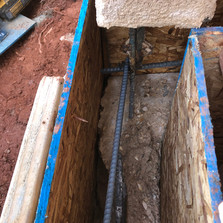
Foundation Repair

Foundation Repair for Residential, Commercial, & New Construction
There are several signs that may indicate that you have an issue with your foundation. If your doors and windows don't close properly anymore, or you notice cracks around the frame, you may have foundation problems.
Sometimes a homeowner first notices cracks on the outside of their home. These cracks generally are between the concrete blocks used in construction of most of today’s homes in Utah. Not only are they unsightly but they indicate that you need a foundation inspection and either subfloor repair or foundation repair.
Using an expert company to help you address the cause of the damage means your home will quickly be safe and secure once again. So when you know that there are issues with the foundations of your home then it really is a case of the sooner you can put those right, the better.
Common signs of potential foundation issues.
 |
|---|
 |
 |
 |
 |
 |
Look for these signs of foundation distress
On the interior of your home, pay attention to:
-
Cracks in drywall
-
Cracks in concrete floors and ceilings
-
Sticking or misaligned doors and/or windows
-
Sloping or sagging floors
On the exterior of your home, look for
-
Gaps in your windows, doors or archways
-
Cracks in your foundation
-
Water intrusion
-
Leaning chimneys
-
Soil separation around your foundation
-
Water pooling or draining around your home
-
Cracks in your garage
You may see sloping floors, walls rotating outward, or separation cracks between the floor and walls. If you have a basement, look for bowed walls, water leaking, cracked floors or walls, and water stains on your floors and walls.
What we do to secure your foundation.


Helicals, also known as pile, is the most common method of dealing with a structure settling. Think of a helical as a large screw that is twisted into the ground. Once the helical is in place, we take a bracket specifically designed to fit under the structure's foundation. Once this is done, the load of the structure will be supported by the helical.
Waterproofing is crucial to the life of the foundation. Concrete is very porous; moisture will seep into the concrete causing rebar to rust and minerals to be deposited. Once this occurs, the expanding rusted rebar begins to break the foundation from the inside out. At the same time the deposited minerals are breaking down the concrete, turning the foundation into gravel. To prevent this and/or remediate, the foundation must be excavated, cleaned, and all cracks filled in. After that a rubber-like material is applied followed up with an acrylic concrete protective coating, protecting the membrane from the back fill.




Ways to Repair a Sinking Foundation
Anytime we pour a concrete foundation, we want it to sit level forever. If the concrete slab ever loses its level seating, it can be fixed with slab jacking.
What is slab jacking?
Slab jacking is a method for lifting a side of the concrete slab so it can sit level again. It doesn’t require breaking up the concrete and creates very little debris.
In homes with basements and crawl spaces, jacks can raise the foundation. But when the house sits on concrete slab, the whole slab cannot be lifted.
So how does slab jacking work?
First, holes are drilled into the foundation, about half an inch in diameter.
Next, stable materials are pumped into the holes. When this material consists of natural materials, it creates a muddy slurry and is known as mud jacking. Polyurethane foam is a popular alternative to mud.
Mud is less expensive than poly foam, but foam is often the better solution.
The benefit of polyurethane foam in slab jacking is that the slab is not raised by the pressure from the pump. Instead, the polyurethane foam expands and slowly raises the foundation.
And unlike the natural materials used for mud jacking, polyurethane foam is also resistant to erosion.
Once the raised slab sits level again, workers plug the holes that they drilled at the start.
Additional Foundation Repair Solutions
We also offer a wide range of additional services designed to prevent and remedy severe foundation damage. Learn more about our foundation repair solutions, or contact us today for a free estimate.
Carbon Fiber Strips
Carbon fiber strips are used to support and relieve pressure on bowing walls. They can also be used for crack repair. Carbon is among the strongest materials in the world, making these strips can be an effective and affordable alternative to major repairs.
Basement Wall Anchor Systems
Our basement anchor systems reinforce your basement walls where bowing, deterioration, or other damage has occurred. These anchors are inserted through the walls to provide stability and structural integrity.
Tuckpointing
Tuckpointing is the process of replacing the mortar between the bricks in your foundations to ensure that it is properly sealed and maintained. This is a great way to prevent water from penetrating your home and causing further damage.
Underpinning
Underpinning is an advanced solution for foundations that need extra support due to damage or additional load-bearing, such as an addition. Underpinning increases the depth of the foundation by inserting pins under the structure to provide extra stability.
Foundation Shims
Foundation shims are thin steel strips that are used to reinforce the underside of the foundations when homes are built on concrete slab foundations. These shims can help make your home more level while strengthening the foundation.
OUR TEAM AT WORK






Our service area
Serving Utah and nearby areas


